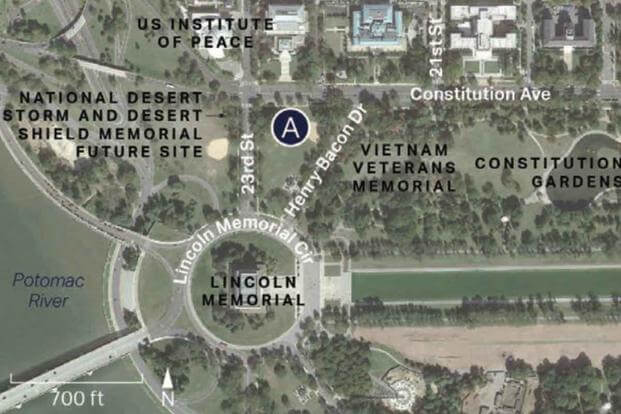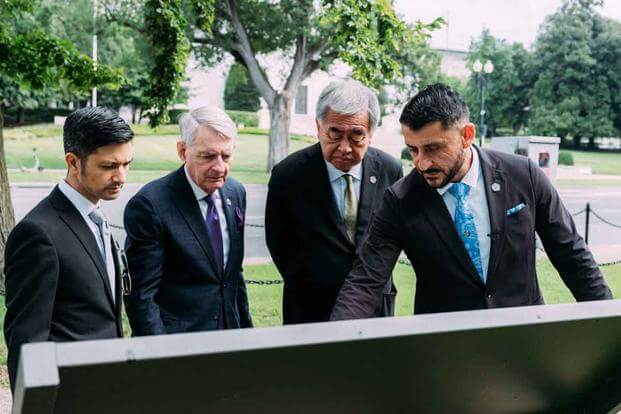ATLANTA — Japanese architect Kengo Kuma — designer of Tokyo’s new National Stadium, one of Time Magazine’s 100 Most Influential People of 2021 and an advocate of architecture that blends into the surrounding landscape — will serve as the lead designer for the National Global War on Terrorism Memorial in Washington, D.C.
The decision was announced at the 2024 Military influencer Conference in Atlanta on Tuesday by Global War On Terrorism Memorial Foundation CEO Michael Rodriguez.
“Kuma-san leads Kengo Kuma & Associates, a team of over 400 people worldwide,” Rodriguez said. “They ensure people, experiences and beauty are at the forefront of every single project.
Read Next: Army Testing Robot Dogs Armed with Artificial Intelligence-Enabled Rifles in Middle East
“We want every person who sacrificed for our country and the world to know that this memorial is a tribute to your courage, your story and your life,” he added. “This will be our legacy. I can assure you that this mission is approached with the sanctity, reverence and love it deserves.”
“I believe this memorial is extremely important, not only for America but for the entire world. Terrorism is a global issue, one shared by all countries,” Kuma told the foundation. “The situation we face today is complex, and this memorial can symbolize hope. It’s a message that the world desperately needs.”
Kuma designed the Asakusa Culture Tourist Information Center in Tokyo, the Dallas Rolex Tower and the Dundee Museum in Dundee, Scotland. He has a deep, personal connection to the Global War on Terrorism: He lost a close friend in the Sept. 11 attacks and told Rodriguez he felt the invitation to become the lead designer was an invitation from his friend.
“I lost my dear friend [Yoichi] Sugiyama in the World Trade Center on September 11th,” Kuma said. “He worked for Fuji Bank in Berlin and left behind his wife and two children. He was such a kind, hardworking family man. The World Trade Center seemed so strong — it was one of the most beautiful buildings in the world — and then, suddenly, it disappeared, and my friend was gone. It’s hard to find the words to express those feelings.”

The Global War on Terrorism Memorial Foundation worked since 2015 to create a national memorial in Washington. It has since overcome a number of seemingly insurmountable hurdles on the way to actually breaking ground.
First, the foundation required an act of Congress to waive the 10-year statutory waiting period following the end of a conflict to begin the construction of the memorial. The Global War on Terrorism Memorial Act was signed by President Donald Trump in 2017.
The next significant hurdle was getting a reserved location for the memorial on the National Mall, another effort that required yet another act of Congress. The foundation lobbied for passage of The Global War on Terrorism Memorial Location Act for two years before President Joe Biden signed it into law in 2021.
Today, the memorial is prohibited from using federal funds for its construction, and the memorial foundation has seven years to finalize a design for the memorial and raise the necessary funds to build it. The chosen site of the memorial is between the Vietnam Veterans Memorial and the future site of the National Desert Shield and Desert Storm Memorial, at 23rd Street NW, Constitution Avenue NW and Henry Bacon Drive NW.

Kuma will lead the design team, but the design will be informed by the foundation’s Design Advisory Council made up of Gold Star family members and veterans, as well as surveys from more than 20,000 veterans on what the memorial should look like. As Rodriguez put it, Kuma will “sit there as the vessel of our message.”
“I believe the memorial should also convey a simple, yet powerful message,” Kuma said in a statement. “We can all share in the idea together that we want to do our best to achieve that kind of special memorial.”
Related: Cost Estimate for Global War on Terrorism Memorial Balloons to $100 Million
Story Continues
Read the full article here

